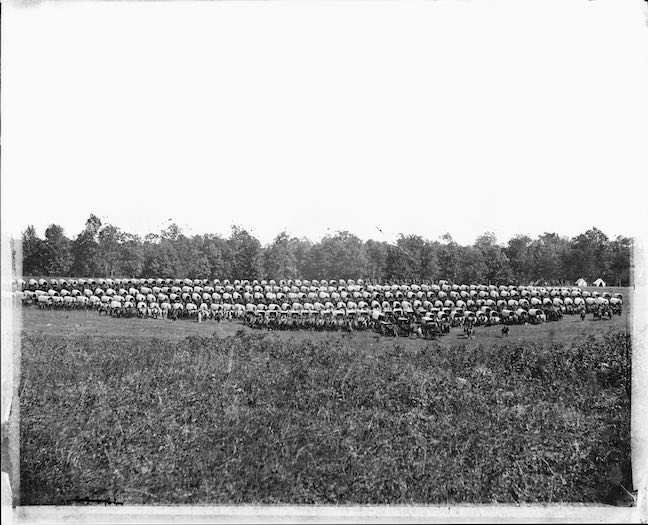| Credit: | by OSullivan (Timothy H.) |
|---|---|
| Date: | 1864.05 |
| Negative Size: | 8 in. x 10 in. |
| Equipment: | mule; wall tent; wedge tent |
| Locations & Lines: | Brandy Station VA; Virginia |
| Military Units: | Army of the Potomac; Quartermaster Department (US) ; US Army |
| Transports: | ambulance wagon; freight wagon |
| Sources: | Library of Congress; National Archives; USAMHI – MOLLUS collection; University of Maryland (Baltimore County) |
$6.99
File Details: AILSm, 750 DPI, TIFF, Copy Negative, 42.6 Mb
Image ID: AILS
Gardners Photographic Sketch Book Of The War. Vol. 2, No. 64. Wagon Park, Brandy Station, Virginia. May, 1863. This wagon park represents the transportation of all that portion of the Quartermasters Department, which included the various field repair shops, carpenter, saddlers, harness-makers, blacksmiths, wheelwrights, wagon builders, and the like, belonging to the Army of the Potomac. When in full operation it was a very extensive establishment, and one of much importance to the army. Thousands of mules and horses were here shod every month, and almost an equal number of disabled wagons, ambulances, &c., repaired, the rough usage to which the trains were subjected breaking down even the strongest-built wagons. In addition to the repairs done here, there were made tables, seats, and desks, for office furniture, required by the various departments in camp. Indeed, it would be difficult to say what the Quartermaster might not have to construct or mend at a moments notice. Sometimes Col. Pierce, the officer in charge, would find a whole division of cavalry upon his hands, in the most unexpected manner; just in from a raid or fight, their own proper depot out of reach, and all in want of shoes to their horses and repairs to their equipments. Then there were lively times at the repair shops; harness-sewers working to distraction, and blacksmiths punishing their anvils day and night, while the cry was still they come. At other times, while the summer campaigns were in progress, there would be little to do but keep the mules harnessed for a start, and lounge upon the ground, or around the sutlers wagon. This train numbered about two hundred and forty wagonsno trifling command to move with precision and safety over a country almost destitute of paved roads; but when compared with the entire transportation of the army, it was a small matter. For the carriage of ordnance, commissary and quartermaster stores, the baggage of the troops, and for transporting the sick and wounded, nearly six thousand wagons and ambulances had to be put to motion, requiring at least sixty miles of road to string out upon. Moving upon dirt roads, generally cut up by the wheels of over three hundred guns, the same number of caissons, the accompanying forges and battery wagons, and a pontoon train or twothe labor required by the draught animals was excessive. As for the swearing done by the teamsters, no words can describe its amount, nor can any memory do justice to its variety and originality. But for those immense trains, and their cumbrous movements, many a battle would have remained unfought, and engagement sometimes being absolutely necessary for their preservation. One of these was the battle of Bristow Station, where the rebel army made a flank attack upon the Second Corps, hoping, by a vigorous assault, to drive our men, and cripple the army by destroying the train, moving under cover of the column of infantry.
When collected in one encampment, the sight of the vast parks of wagons was very imposing. On our occasion, two days before the battle of Bristow, almost the entire transportation of the army was accumulated in the vicinity of Bealton, covering the fields in all directions as far as the eye could reach with white covers, all stamped, with the badge of their respective corps, division and brigade.
Etched onto negative: 2136 [crossed out]. No. 268.

